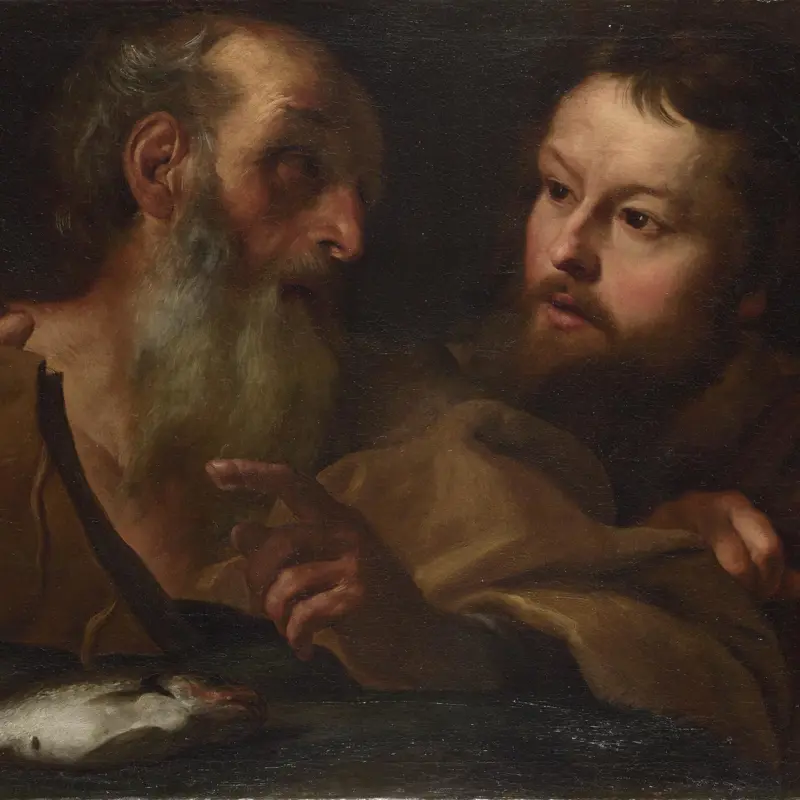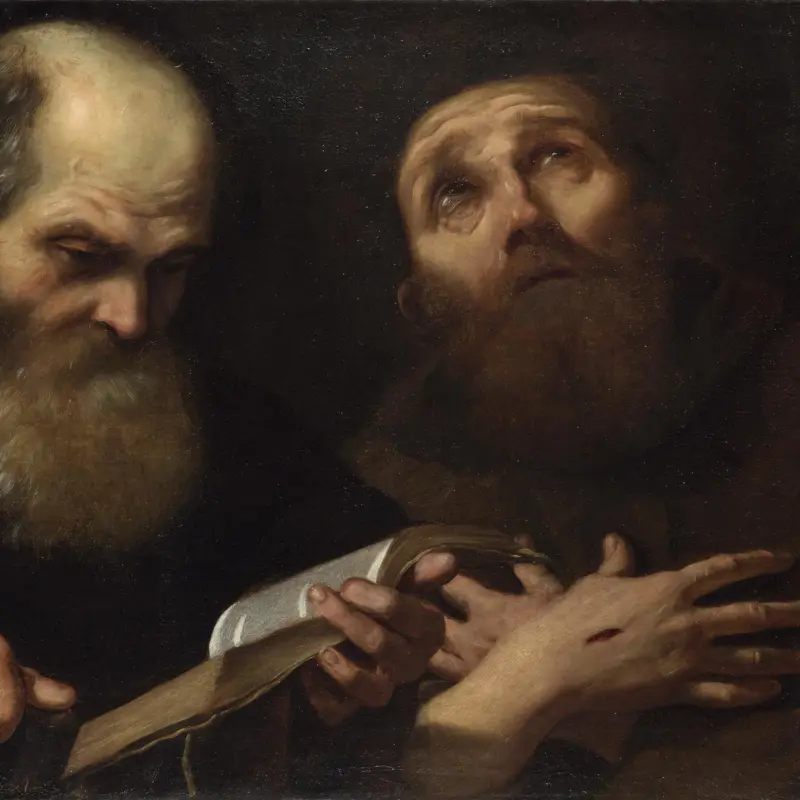Andrea Sacchi, 'Saints Anthony Abbot and Francis of Assisi', before 1627
About the work
Overview
Holding a book that seems to thrust forward out of the picture plane is Saint Anthony Abbot, identified by the tau- (T-) shaped walking stick he used in later life. He also wears a black habit, which his followers, the Antonine monks, later adopted. Next to him, slightly set back, is Saint Francis of Assisi, with his dark brown friar’s habit and a bloody wound on his hand. This is one of the stigmata – the five wounds suffered by Christ on the Cross, which were miraculously visited on the saint.
Sacchi has created a simple but effective contrast between the two meditative saints. They appear to share the same physical space, lit by a bright, raking light from the left, but they seem unaware of each other. Saint Anthony is immersed in his studies; Saint Francis’s hands are crossed in religious submission, and his gaze is turned heavenwards. A painting by Gian Lorenzo Bernini, Sacchi’s contemporary, which depicts two saints and has a similar format and dimensions is also in the National Gallery’s collection.
Key facts
Details
- Full title
- Saints Anthony Abbot and Francis of Assisi
- Artist
- Andrea Sacchi
- Artist dates
- 1599/1600 - 1661
- Part of the series
- Four Saints for Palazzo Barberini
- Date made
- Before 1627
- Medium and support
- Oil on canvas
- Dimensions
- 61 × 78 cm
- Acquisition credit
- Presented by Messrs P. and D. Colnaghi, 1967
- Inventory number
- NG6382
- Location
- Not on display
- Collection
- Main Collection
Provenance
Additional information
Text extracted from the ‘Provenance’ section of the catalogue entry in Michael Levey, ‘National Gallery Catalogues: The Seventeenth and Eighteenth Century Italian Schools’, London 1986; for further information, see the full catalogue entry.
Bibliography
-
1969The National Gallery, The National Gallery: January 1967 - December 1968, London 1969
-
1986Levey, Michael, National Gallery Catalogues: The Seventeenth and Eighteenth Century Italian Schools, London 1986
-
2001
C. Baker and T. Henry, The National Gallery: Complete Illustrated Catalogue, London 2001
About this record
If you know more about this work or have spotted an error, please contact us. Please note that exhibition histories are listed from 2009 onwards. Bibliographies may not be complete; more comprehensive information is available in the National Gallery Library.
Images
About the series: Four Saints for Palazzo Barberini

Overview
These paintings were made by two rising stars of the art world in Rome in the 1620s – one by Gian Lorenzo Bernini, the other by Andrea Sacchi. Both depict two saints at half-length, tightly framed and dramatically lit. They are almost exactly the same size, seem to have been made at around the same date and were in the collection of the powerful Barberini family.
It has been suggested that they were made as companion pieces, but documents suggest that the Sacchi painting wasn’t acquired by the Barberini until 1661 at the earliest, more than 30 years after they bought Bernini’s picture. Close examination has also shown that the Bernini painting was trimmed along both vertical sides after it was finished while the Sacchi was extended slightly, presumably so that the sizes of the two would match. On balance, it seems unlikely that they were originally made as a pair. Instead, the similarities seem to have tempted the Barberini family to adapt the pictures and hang them together at a later date.


